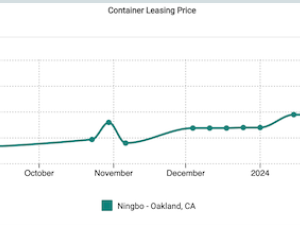Container shipping lines serving the Asia-US freight market forecast that the operating cost of a typical sailing, delivering a container load of cargo to US ports and inland points, will increase by an average of more than seven percent during 2006.
That estimate, developed internally by member lines in the Transpacific Stabilization Agreement (TSA) carrier discussion group, includes predictions of up to 25% increases in inland rail and trucking transportation costs, and 11% increases for basic empty container repositioning. Other cost elements include non-terminal container handling, Asia feeder ship service, maintenance and repair, staffing, information systems, and sustained network costs relating to the 2.5-to-1 imbalance in transpacific cargo and equipment. The forecast does not factor in peak season, bunker and inland fuel ' which continue to set new weekly record levels ' and other costs covered by separate charges.
In preparing their forecast, TSA lines did not include congestion-related costs, as port congestion has been infrequent in 2005. The lines also took care to exclude any intermodal costs from their West Coast port-to-port calculations.
'Cargo growth from Asia has placed intense service and cost pressures on container lines during the past year,' said TSA Executive Director Albert A. Pierce. 'They've added vessels, diversified routes, improved load planning in Asia to increase throughput at US ports, and worked with customers to cover contingencies and meet tight delivery schedules, with no questions asked. At some point, however, carriers have to go back, add up the price tag for these efforts and begin talking about cost recovery.' Pierce added that the cost impacts in the coming year are made even more acute by the fact that carriers were not able to fully recover dramatically higher costs in 2004-05, when infrastructure congestion was at its worst ' including launch and operation of all-water services to the East Coast via the Panama Canal to bypass Southern California congestion.
TSA expects Asia-US cargo demand to continue growing in 2005-06, with traffic continuing at record levels. With new ship capacity continuing to be constrained by harbor and inland infrastructure limitations, the Agreement sees no more than a 3-4% gap between capacity and demand during 2006 ' and less during the peak fall shipping season.
Pierce explained that carriers must adequately build rising costs and a measure of profitability into their 2006-07 pricing. 'It's an oversimplification to focus solely on ship capacity versus projected demand,' he said. 'Supply chain capacity is systemwide. We need to bring drivers back into the trucking industry; encourage railroad investment in locomotives, track and more efficient yards; add freight lanes to harbor area highways, and reconfigure port terminals to add throughput. Ocean carriers will be paying out for those and other improvements next year. They can't cover the costs alone.'






